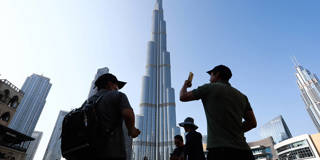The most recent Arab Youth Survey suggests a growing battle between optimism and pessimism, especially when it comes to the economy. To address their concerns, policymakers must shield households in the Middle East and North Africa from rising prices and provide more support for entrepreneurship.
WASHINGTON, DC – Optimism can be difficult to muster at a time of heightened uncertainty and global turmoil. The 2022 ASDA’A BCW Arab Youth Survey, conducted only a few months after Russia’s full-scale invasion of Ukraine and on the heels of the COVID-19 pandemic, reflected a darkening economic outlook. Rapidly rising commodity prices and supply-chain disruptions were fueling inflation worldwide, and higher food prices were straining low-income households and undermining food security in many parts of the Middle East and North Africa (MENA).
Not much has changed in the year since. Despite some easing since the end of 2022, price pressures remain stubbornly high; this year, inflation is expected to average around 15% in the Arab world. Many of the region’s central banks continued tightening monetary policy to prevent inflation expectations from de-anchoring. Coupled with turbulence in global financial markets and increased policy uncertainty, this could dampen economic activity for the foreseeable future.
Given this context, it is no surprise that rising living costs and unemployment were the most pressing concerns for young Arabs. The 2022 survey covered five Gulf Cooperation Council (GCC) states (Bahrain, Kuwait, Oman, Saudi Arabia, and the United Arab Emirates), North Africa (Algeria, Egypt, Libya, Morocco, Sudan, and Tunisia), and the Levant (Jordan, Iraq, Lebanon, the Palestinian territories, Syria, and Yemen), where stark disparities in income and wealth remain.

WASHINGTON, DC – Optimism can be difficult to muster at a time of heightened uncertainty and global turmoil. The 2022 ASDA’A BCW Arab Youth Survey, conducted only a few months after Russia’s full-scale invasion of Ukraine and on the heels of the COVID-19 pandemic, reflected a darkening economic outlook. Rapidly rising commodity prices and supply-chain disruptions were fueling inflation worldwide, and higher food prices were straining low-income households and undermining food security in many parts of the Middle East and North Africa (MENA).
Not much has changed in the year since. Despite some easing since the end of 2022, price pressures remain stubbornly high; this year, inflation is expected to average around 15% in the Arab world. Many of the region’s central banks continued tightening monetary policy to prevent inflation expectations from de-anchoring. Coupled with turbulence in global financial markets and increased policy uncertainty, this could dampen economic activity for the foreseeable future.
Given this context, it is no surprise that rising living costs and unemployment were the most pressing concerns for young Arabs. The 2022 survey covered five Gulf Cooperation Council (GCC) states (Bahrain, Kuwait, Oman, Saudi Arabia, and the United Arab Emirates), North Africa (Algeria, Egypt, Libya, Morocco, Sudan, and Tunisia), and the Levant (Jordan, Iraq, Lebanon, the Palestinian territories, Syria, and Yemen), where stark disparities in income and wealth remain.